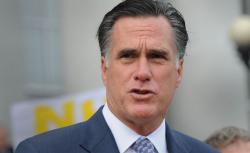President Obama’s aides and allies have been working hard to put energy back in the “Mitt Romney is a flip-flopper” story. Today, the New York Times presented them with a new opportunity, with a story suggesting that Romney was embracing the flat tax after once opposing it. The Democratic National Committee sent out a memo to reporters: “Imagine that—Mitt Romney Hedges (Flip-Flops) on an Issue.” The Democratic Party of New Hampshire issued a similar release.
But Romney’s statements about the flat tax show the opposite: He’s been consistent over the years.
In 1996, when Steve Forbes threw the Republican presidential primary into turmoil with his flat tax plan, Romney jumped into the fray. Using $50,000 of his own money, he bought full-page ads in New Hampshire and Des Moines bashing the idea. He called it a “tax cut for fat cats” because it did not tax dividends, capital gains or interest. The flat 17 percent tax would mean taxes for “Kennedys, Rockefellers and Forbes[es]” would be “DOWN or GONE,” read the ad. Taxes on “you” would be “UP and UP!” (Forbes didn’t forget. On Monday he endorsed Perry, who is offering a flat tax of his own in a speech Tuesday.)
Usually Republicans balk when Democrats start talking about the difference between the poor, the middle class, and the wealthy. Romney was not alone in making this distinction in 1996. Dole warned the “middle class will take it on the chin.” Lamar Alexander, Pat Buchanan and Phil Gramm—who called himself a “blue-collar Republican”—also criticized the plan because it would allow the wealthy to live off investment income without paying taxes. Newt Gingrich was also against that provision. “That’s nonsense,” Gingrich said at the time. “That’s not going to happen.”
The Forbes response was that the money had already been taxed once at the corporate level. One of Forbes’ key points was that removing double taxation was a matter of fairness.
At the time, Romney said he liked the flat tax in theory. “There are a number of flat tax proposals around that would be better than the tax system we have now,” he told the Boston Globe at the time. “The middle class should be the priority for a tax cut,” he said. “Those are the people struggling to pay college tuitions and make families work.”
That answer from 1996 sounds almost identical to one Romney gave on the flat tax last Thursday in Sioux City, Iowa. In a town hall meeting, Romney was asked about the tax code, and in his response he brought up the flat tax. “The flat tax has positive features. Then you have to make sure it doesn’t raise taxes on middle income Americans. For me one of the key criteria in looking at tax policy is we help the people who need the help most. In our country the people who need the help most are in the middle class.”
To help the middle class, Romney’s current economic recovery package eliminates all taxes on capital gains, dividends, and interest for those making less than $200,000. Here he runs into something that’s not a flip-flop so much as an amusing irony: His plan won’t make much of a difference for the middle class. Only a small percentage of the people who incur those taxes make less than $200,000. Who says? Why, Mitt Romney—in 1996. His ad cited those three famously wealthy families because it’s the rich, not the middle class, that benefit most from elimination of capital gains, dividends, and interest taxes.
The Times story digs up a quote from August of this year, in which Romney says, “I love the flat tax.” But the rest of that quote contains all the usual ifs and buts. Since 1996 Romney has held essentially the standard GOP view, which is in support of effective and politically unrisky tax simplification. Taxes should be flat but not without hurting the middle class, which means retaining some of the trinkets and loopholes in the current code, such as the mortgage interest deduction. Flat-tax purists say that’s not really a flat tax, which is why Romney and others talk about a “flatter tax.”
Now that we’ve cleared this up, can we all agree that the Democrats have achieved their goal? People have been given another opportunity to think about Mitt Romney as a flip-flopper. And while they’re thinking, they might judge other evolutions in that same vein. In that 1996 ad, Romney lists a host of priorities he says the candidates should focus on instead of the flat tax. In addition to balancing the budget and reducing the number of abortions, he also lists campaign-finance reform and universal health care—issues he doesn’t talk about much in 2011.
